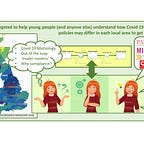If Covid 19 in London is 70% more infectious it’s a triple whammy
By Farrah Farnejad, Maurice Glucksman, Alan Patrick and Dr Kim Warren
You may be wondering: Why is a 70% more infectious mutation of Covid 19 cause for the Government to immediately declare a Tier 4 emergency in London? 70% is not certain but if it is verified the consequences can be explosive. We believe the Government acted prudently.
This very dense chart shows what happens in Westminster if a 70% more infectious mutation takes over. If you don’t want to bother with the chart, you can sum it up as: a triple whammy. It translates to many more severe infections and deaths if we can’t slow it down.
There is a lot of information in this chart and much more information available in the Covid 19 Westminster model but from this analysis it is clear that at this time the risk is hugely increased by the possibility of a 70% more infectious mutation. In summary from top left:
- In chart 1 the mutation more than doubles the scale of projected reported cases/day from 80 to 180 in February. But to see the real situation you must measure the invisibles. If we could measure actual cases per day feeding the total infections in charts 4 and 5 it would peak at 2300 or 13x the number reported
- In chart 2 without the mutation and no actions vaccines could save 100 deaths. With extra vigilance 250 lives could be saved
- In chart 3 with the mutation we project the vaccine will come too late to impact the deaths unless the spread is slowed down. With the mutation everything moves faster. Vaccines save 55 deaths. With extra vigilance 275 saved
- In chart 4 peak infections circulating with no mutation is 15,000 in February: 6% of the population. In chart 5 with mutation about 33,000 people in Westminster will be circulating infected: 13% of the population. That on its own more than doubles the risk of being infected on top of the 70% for a combined infection risk up 3.7x compared with no mutation in February. Many of these infections would not happen with no mutation because more vaccinations would happen. So on top of the 70% that’s the double whammy.
- In chart 5 vaccines at current rate of availability are not a solution but vigilance can give them time to act and this results in a much lower infection rate
- in chart 6 severe cases at home double with the mutation. That is partly because there are a limited number of hospital beds in our model and a certain percentage of people infected do not seek hospital care. When infection rates explode this constraint limits hospital admissions and more people just decide to stay home. Severe cases at home are at least twice as likely to die than people with hospital care. That’s the triple whammy
So you might ask: if it’s 3.7x risker in February and death is twice as likely if you stay home why aren’t deaths 3.7 x 2=7.4 times greater in our simulation?
Getting infected does not change your likelihood of a severe infection or death unless you can’t get hospital care. What it does instead is change the timing. That is critical because many people will be infected earlier —so more people get infected before they can be vaccinated. The same proportion of those extra infections (just under 1% is the track record so far in London) are severe. Our model produces and estimate from the data that survival rates have about doubled treating people with a severe infection since March and April but still about 0.2% of infections in London lead to death.
The model accounts for all these factors and the result is with vigilance, deaths going forward could be cut by 90%. The achievable impact is more than 7.4x.
Our assumptions are the levels of vigilance required to slow the spread enough to allow vaccinations to happen are consistent with what has been achieved in Westminster so this is not theoretical, it could be done. But that depends on whether the residents of Westminster can hold out and allow the vaccination program time to roll out.
The model of Westminster is not representative of London as a whole. Covid 19 has spread much faster in other areas of London.
Paradoxically this means that fewer people are likely to remain susceptible in those badly hit locations so the risk going forward may be lower.
Other areas have been less impacted than Westminster so far so there are a higher proportion of susceptible people and in those areas the risk is higher. Therefore, it is not accurate to scale up the results from Westminster to get an answer for Greater London. However, it is directionally indicative.
Scaling up in proportion to population, although not accurate, gives a good estimate for what happens if vigilance can be maintained. For Greater London saves 9500 lives and about the same number of severe infections and the long-term health issues.
Waiting with vigilance in Tier 4 for a few weeks to have the confirmation of the data on infectiousness of the mutation seems to be a prudent decision for London.
* * * * * * * * * * * * * * * * * * * * * * * * * *
Farrah Farnejad is a second year student of Global Health at Queen Mary University of London & winner of The Covid 19 Youth Modelling Competition for her model of Westminster used to produce the analysis in this article
Maurice Glucksman and Dr. Kim Warren are Co-lead Architects of The Covid 19 Localisation Modelling Group
Alan Patrick is Founder and Director of Dataswarm Limited . Alan has authored articles early on in the pandemic on London and he has modeled the outbreak in Stockholm
enquiries: info@localcovid19model.org
